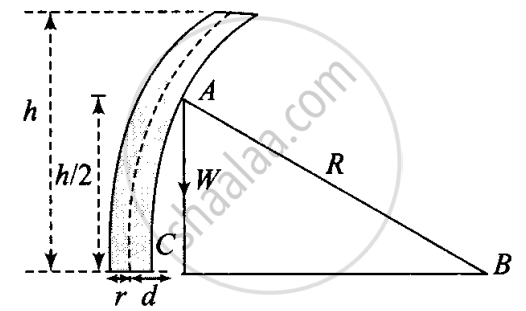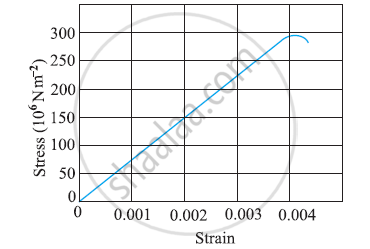Advertisements
Advertisements
Question
In nature, the failure of structural members usually result from large torque because of twisting or bending rather than due to tensile or compressive strains. This process of structural breakdown is called buckling and in cases of tall cylindrical structures like trees, the torque is caused by its own weight bending the structure. Thus the vertical through the centre of gravity does not fall within the base. The elastic torque caused because of this bending about the central axis of the tree is given by `(Ypir^4)/(4R) . Y` is the Young’s modulus, r is the radius of the trunk and R is the radius of curvature of the bent surface along the height of the tree containing the centre of gravity (the neutral surface). Estimate the critical height of a tree for a given radius of the trunk.
Solution
According to the problem, the elastic torque or the bending torque is given and we have to find the torque caused by the weight due to bending.
The diagram of the given situation is as shown.
The bending torque on the trunk of radius r of the tree = YπR4/4R where R is the radius of curvature of the bent surface.

`τ = Wd = (Ypir^4)/(4R)`
Here deforming torque is equal to elastic torque (restoring torque) caused by the bending of tree about its central axis when the tree is about to buckle.
Let h be the height of tree. If R >> h, then the centre of gravity of the tree is at a height of h/2 from the ground.
Refer to the figure in ΔABC
`R^2 = (R - d)^2 + (h/2)^2`
= `R^2 - 2Rd + d^2 + h^2/4`
Since, d << R, therefore the term d2 being very very small can be neglected.
∴ `R^2 = R^2 - 2Rd + h^2/d`
or `d = h^2/(8R)` ......(i)
If `omega_0` is the weight/volume, then
`(Ypir^4)/(4R) = omega_0 (pir^2h) h^2/(8R)` .....[∵ Torque is caused by the weight]
⇒ `h = ((2Y)/(omega_0))^(1/3) r^(2/3)`
Hence, critical height = `h = ((2Y)/(omega_0))^(1/3) r^(2/3)`.
APPEARS IN
RELATED QUESTIONS
The figure shows the strain-stress curve for a given material. What are (a) Young’s modulus and (b) approximate yield strength for this material?

A 14.5 kg mass, fastened to the end of a steel wire of unstretched length 1.0 m, is whirled in a vertical circle with an angular velocity of 2 rev/s at the bottom of the circle. The cross-sectional area of the wire is 0.065 cm2. Calculate the elongation of the wire when the mass is at the lowest point of its path.
Two wires A and B are made of same material. The wire A has a length l and diameter rwhile the wire B has a length 2l and diameter r/2. If the two wires are stretched by the same force, the elongation in A divided by the elongation in B is
A wire elongates by 1.0 mm when a load W is hung from it. If this wire goes over a a pulley and two weights W each are hung at the two ends, he elongation of he wire will be
A steel rod of cross-sectional area 4 cm2 and 2 m shrinks by 0.1 cm as the temperature decreases in night. If the rod is clamped at both ends during the day hours, find the tension developed in it during night hours. Young modulus of steel = 1.9 × 1011 N m−2.
Young's modulus of a perfectly rigid body is ______.
A steel wire of mass µ per unit length with a circular cross section has a radius of 0.1 cm. The wire is of length 10 m when measured lying horizontal, and hangs from a hook on the wall. A mass of 25 kg is hung from the free end of the wire. Assuming the wire to be uniform and lateral strains << longitudinal strains, find the extension in the length of the wire. The density of steel is 7860 kg m–3 (Young’s modules Y = 2 × 1011 Nm–2).
A steel rod of length 2l, cross sectional area A and mass M is set rotating in a horizontal plane about an axis passing through the centre. If Y is the Young’s modulus for steel, find the extension in the length of the rod. (Assume the rod is uniform.)
In nature, the failure of structural members usually result from large torque because of twisting or bending rather than due to tensile or compressive strains. This process of structural breakdown is called buckling and in cases of tall cylindrical structures like trees, the torque is caused by its own weight bending the structure. Thus the vertical through the centre of gravity does not fall within the base. The elastic torque caused because of this bending about the central axis of the tree is given by `(Ypir^4)/(4R) . Y` is the Young’s modulus, r is the radius of the trunk and R is the radius of curvature of the bent surface along the height of the tree containing the centre of gravity (the neutral surface). Estimate the critical height of a tree for a given radius of the trunk.
If Y, K and η are the values of Young's modulus, bulk modulus and modulus of rigidity of any material respectively. Choose the correct relation for these parameters.
